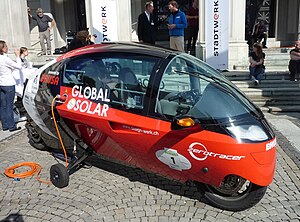Zerotracer
| Design work | |
|---|---|

|
|
| Zerotracer | |
| Manufacturer | Designwerk Technologies GmbH |
| Production period | 2009 to 2009 |
| class | Scooter |
| Motor data | |
| Electric motor | |
| Power (kW / PS ) | 135/183 |
| Top speed ( km / h) | Electronically governed 240 km / h |
| Dimensions (L × W × H, mm): | approx. 3650 × maximum 1400 × approx. 1520 |
The Zerotracer is a cabin motor scooter and a light electric vehicle for two people. The vehicle was developed in Winterthur for participation in the Zero Emission Race . The competition started under the auspices of UNEP on August 16, 2010 in front of the United Nations Palace in Geneva and also ended there on February 24, 2011 after 80 days of driving - probably based on the journey described by Jules Verne. It was also in time to take part in the Geneva Motor Show as the winner of the race .
Zero Emission Race
The endurance test for the three vehicles reaching their destination led via Brussels , Berlin , Kiev and Moscow to Chelyabinsk , near the border with Kazakhstan . From Almaty the route continued to Ürümqi in the Xinjiang Uyghur Autonomous Region in China . From Shanghai , which was reached from there , they embarked for Vancouver , from where they headed for the west coast along Mexico to appear at the World Climate Summit in Cancún . After shipping across the Atlantic, the final section from Casablanca to Geneva was taken under the wheels.
The Zerotracer achieved the highest number of points during the race and is considered the winner. A single interruption - which must be made up afterwards - resulted from a collision with a cyclist in Vancouver, when he changed his lane without expecting an almost silent vehicle.
Services
At an average speed of 80 km / h, 7 kWh of energy are used per 100 km. According to the official website, this value is even reached at 100 km / h. This corresponds to one sixth of the efficiency targeted by the EU by 2015. The maximum speed of the vehicle is electronically limited to 240 km / h, with 135 kW more than 300 km / h possible. Due to the small cross-section of the vehicle, the Zerotracer has a very low drag coefficient . In addition, the rolling resistance is reduced due to the low curb weight. In the race, on the other hand, air resistance played a lesser role on the Asian parts of the track; the construction was able to successfully prove its reliability there. The entire distance from Geneva to Shanghai could be covered without interruption due to breakdowns.
Concept and development
The basic construction of this vehicle goes on MonoTracer of Peraves back. Based on that name (to be translated as “single-track”), the conclusion that it is much more a single-track car than a motorcycle. If you look at all the other models under electric motorcycles and motorcycles , it becomes clear that the Zerotracer has very little relationship with those (even vehicles that are only half as long): three-point belts, foot brake pedal and those feet never on the ground - and therefore always dry- point to the properties of a vehicle type previously known as a car. It also corresponds to a vehicle in which structural elements of a low-energy vehicle are used "outside of city traffic".
At Designwerk , the Zerotracer is an internal project and an affair of the heart that is not given out of hand. This successful Zerotracer is to be followed by a further refined version. The vehicle around the world already had full road approval with three-point seat belts and all comfort elements. This is in contrast to the solar taxi , the first circumnavigation of the world by solar vehicle.
The body is constructed from Kevlar composites. The PSI batteries, including the control electronics, are supplied by Dreifels from Switzerland, while the most important sponsor, Oerlikon Solar, supplied components from OC Oerlikon as well as the power for the circumnavigation of the world from their photovoltaic system. The motor comes from BRUSA Elektronik AG, from Sennwald in the St. Gallen Rhine Valley, which means that the monotracer is largely a Swiss product.
Picture gallery
See also
Web links
- ↑ a b Oliver Karthaus: Around the world in 80 days: Swiss people win Zero Emission Race ( Memento from February 28, 2011 in the Internet Archive ) DailyGreen Internet portal, February 25, 2011
- ↑ Zerotracer at the Geneva Motor Show 2011
- ↑ Zerotracer on the Zerotracer homepage ( Memento from October 8, 2011 in the Internet Archive )
- ↑ About ( Memento from January 26, 2013 in the Internet Archive )


